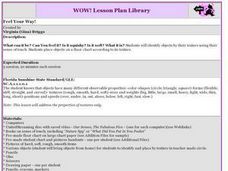Curated OER
Apples Galore! (Elementary, Language)
Fifth graders examine and taste 7-8 difference apples, describe the flavor/texture, then graph the results of favorites. Finally students write a paragraph describing their favorite.
Curated OER
Introduction to Inventions
Fourth graders construct an invention to the best of their creative ability using the teacher provided resources. They identify four scientific processes during the experiment and log them on the teacher prepared ditto.
Curated OER
Recording Treasure
Students participate in a garage sale. They will weigh the items sold. They will calculate the total weight of items sold and donated to an agency.
Curated OER
From Bolls To Bolts
Students investigate the concept of cotton manufacturing. The skills of setting statements in chronological order is developed. They are shown pictures of products and place them in order. The lesson includes background information for...
Curated OER
Feel Your Way!
Young scholars investigate the sense of touch as they examine the texture of items in the classroom and from their homes. They watch a computer based video about the senses and draw items that are rough, smooth, soft, and hard.
Curated OER
The Bill Of Rights And The News
Students investigate the concepts related to the Bill Of Rights. They conduct research using a variety of resources and focus upon the human rights provided in the legislation. Students read a news article and reflect the upon the...
Curated OER
Dolphins And Penguins
Students participate in an activity that reinforces vertical addition sentences as well as provides facts about penguins. They assess a kinesthetic/visual activity to reinforce the difference between vertical and horizontal addition...
Curated OER
Mussel Movements
Students consider the impact of invasive species on local environments. In this ecology lesson, watch the video, Arizona Wildlife Views, which focuses on invasive species. Students develop vocabulary, relate to meaningful comprehension...
Curated OER
Where's the Evidence?
Eighth graders observe evidence of chemical reactions. For this chemical reactions lesson students study chemical processes and complete a lab activity.
Curated OER
Puzzle Race
Students cooperatively complete a puzzle. For this lesson on working with a group, students must work together with their classmates to assemble a puzzle. The first group to complete their puzzle wins.
Smithsonian Institution
National Museum of African Art: Big and Small Are Tricky
An exhibition that uses African art to explain the concepts of bigness and smallness. In the world of art, big and small can refer not only to physical size but to relative size, to the impression an object makes, or to the largeness of...
Science Buddies
Science Buddies: Small, Tiny, Invisible: How Big Is a Virus?
How big or small are viruses really? In this activity, you will find out by creating a scale model that allows you to compare the size of many different small objects.
Smithsonian Institution
Smithsonian Learning Lab: A Mouse Like a House? A Pocket Elephant?
Teachers can download this teaching package that discusses the limits on animal size, both big and small, and what effect size has on animals. Students will enjoy the hands-on activities described in the lessons. Teachers will appreciate...
Science Buddies
Science Buddies: Big Pieces or Small Pieces: Which React Faster?
Use an Alka-Seltzer to find out how size of a particle affects the speed of a chemical reaction. The Science Buddies project ideas are set up consistently beginning with an abstract, objective, and introduction, followed by a section on...














